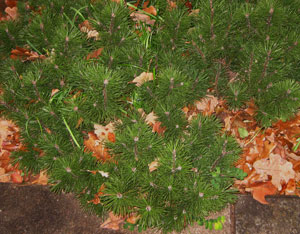Resource Library
Plant of the Week: Pine, Mugo
The University of Arkansas System Division of Agriculture does not promote, support or recommend plants featured in "Plant of the Week." Please consult your local Extension office for plants suitable for your region.
Plant of the Week
Mugo Pine
Latin: Pinus Mugo

Every child knows what a pine tree looks like, but some pines don’t cooperate and follow a different pattern of growth. Mugo pine (Pinus mugo), instead of being a forest giant prized by foresters, is a dwarf, squatty shrub of a pine. How did this very atypical pine from mountainous places in Southern Europe become so common in American gardens?
Mugo pine is sometimes called Swiss mountain pine, though its natural range is throughout much of the mountainous parts of Central and Southeastern Europe. Typically, trees are in the subalpine zone at or near the timber line, though some populations extend further south. It is typically variable in size and shape but mostly under 10 feet tall with a multiple-branched habit of growth, producing plants 1 ½ to 2 times as wide as their height. This squatty growth makes it easy to survive under enormous snow packs and rebuff the effects of avalanches.
It is a two-needle pine with the short, sharp pointed and twisted evergreen needles 1 to 2 inches in length. Needles persist up to five years. Plants are variable in growth rate, and most of the garden forms are selections of Pinus mugo var. mugo, which often produce 2 to 4 inches of extension growth per year. Cones are to 2 inches long and held tightly against the branches.
Mugo pine owes its discovery by the horticultural world to two unrelated events. First, mountaineering became popular in the mid 19th century as a middle class developed during the industrial age. Adventurous sportsmen were drawn to the Alps as a respite from the polluted city centers where they worked. The Matterhorn was first scaled in 1865.
Not everyone that tried mountaineering took to the challenge, but instead many fell in love with the plants of the high mountain meadows. By the 1880s, rock gardening emerged as an enduring garden form that remains with us to this day. These early rock gardeners tried to recreate a natural high-altitude experience in their suburban gardens; not surprisingly, dwarf Mugo pine became part of the mix.
In the Scandinavian countries, especially Denmark and Norway, coastal sand dunes were expanding during the late 19th century, and whole villages had to be relocated due to deforestation that had occurred during past centuries. The Mugo pine had been introduced into Denmark in 1798 and had proven well-adapted and able to colonize poor, infertile and sandy soil. In the last years of the decade, a proposal to “roll out a blanket of Mountain Pine” was proposed as a solution to this problem. The trees to form this blanket had to be grown, so the species experienced a blip in availability during the period when rock gardening was just getting established.
Mugo pine was listed by Philadelphia nurseryman Robert M’Mahon as early as 1806 but, at least surveying the horticultural literature available to me, never became common until the close of the century, when rock gardening took off. In addition, the center of the nursery industry relocated from upstate New York, where mainly deciduous plants were grown, to northern Ohio, where evergreen plants - especially yews, spruce and pines - became the major focus.
This dwarf pine is extremely tolerant of a diversity of planting locations, doing best in full sun or light shade. It tolerates most well-drained soil conditions and is hardy from zone 3 through 7. In addition to use in rock gardens, Mugo pine is often used as a part of the traditional foundation planting, where its unpredictable size can cause problems in future years. Over 40 selections of this species have been named and are propagated by cuttings or grafting. If the plant for sale is reasonably sized and reasonably priced, it is probably a seedling and will eventually attain a large size (in 20 years). If having a compact dwarf plant of known size is critical, pay the money and get a vegetatively propagated clone.
By: Gerald Klingaman, retired
Retired Extension Horticulturist - Ornamentals
Extension News - December 3, 2010
The University of Arkansas System Division of Agriculture does not maintain lists of retail outlets where these plants can be purchased. Please check your local nursery or other retail outlets to ask about the availability of these plants for your growing area.